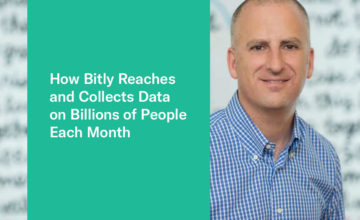Marketing teams have navigated more change in the last 3 years than they have in the last 50 — and in 2020 and during the crisis that now exists, the rate at which companies encounter new decision-making terrain is accelerating.
That’s why simply collecting big data isn’t enough for your business to make sense out of it. Every marketing decision is a series of tradeoffs — if you choose one path, you leave another behind.
Being a successful marketer means being able to keep up with the needs of a fast-moving, fast-changing market. That’s why companies of all sizes need defined, data-driven processes to make their best judgment calls. But the tech sector is still far away from attaining this goal. According to a recent CMO survey from Deloitte, only 40% of marketers report having the quantitative tools necessary to demonstrate the impact of marketing spend on company performance.
The timing is right for marketers to take a pause and rethink their data strategies. Here are some steps to help ensure that your marketing data is doing more of the heavy lifting.
Step 1: Get to the root of why your analytics tools and data strategy make your job harder
Carl F. Mela and Christine Moorman, Professors of Business Administration at Duke University have an interesting perspective that they shared in the Harvard Business Review:
“Data grows on its own terms, and this growth is often driven by IT investments, rather than by coherent marketing goals,” they write. “As a result, data libraries often look like the proverbial cluttered closet, where it is hard to separate insights from junk.”
They further point to an industry trend in which marketers expect to increase their analytics budgets, despite the lack of effectiveness of available solutions.
Yes, you can collect data. You may be able to visualize it and run analyses. But how are these perspectives informing your overall business?
“The gap between the promise and the reality of analytics points to a disconnect that needs resolution,” write Mela and Moorman. “Companies need to better align their data strategy and data analyst talent to realize the potential that analytics can bring to marketing managers.”
That statement begs the question: what’s possible with data?
Step 2: Uncover which questions will steer your business forward
Albert Lee, a data scientist on a mission to make data accessible to a wide range of business units, recently wrote that a company’s success with data comes down to one word: “Why.”
“As a data scientist, I believe that we always need to provide actionable insights instead of just showing results,” he writes. “And by actionable insights, I mean to convince people with the results and recommend the next steps based on the results.”
He elaborates that our data needs to “tell people why the results and recommended steps are crucial.”
Even though we live in accelerated times, the core need of marketing remains timeless. Marketing has and always will be about reaching the right audiences, with the right message, at the right time in a customer’s journey. Your data and data governance efforts need to help you identify questions that will meet your business needs.
Step 3: Create systems that empower everyone to see the same quantitative picture
Mela and Moorman elaborate in their piece for HBR that teams need more than software to be successful with their marketing analytics. One of the biggest challenges that CMOs report is a talent shortage of people who are equipped to work with data.
“The CMO Survey also found that only 1.9% of marketing leaders reported that their companies have the right talent to leverage marketing analytics,” write Mela and Moormon. “Good data analysts, like good data, are hard to find.”
The problem isn’t people; however. The problem is in the data. By design, quantitative information is not easy to interpret — numbers are their own language. The key to working with data isn’t waiting to find good data analysts or to train everyone at your company to think like a data scientist.
Creatives are happy being creative. Brand marketers are happy building brands. But data can help them form better judgment calls. A customer analytics platform, like Indicative, can help companies meet this need by democratizing your company’s data architecture between technical and non-technical audiences.
Step 4: Focus on stories that are timeless, meaningful, and growth-centered
One of the challenges of working with data is that it’s possible to explore any number of rabbit holes. Being a marketer is a fascinating job — you are responsible for understanding, interpreting, and forming stories about people. You could spend hours on just one analysis or dataset.
But you don’t have time to focus on just one thing because you need to do everything. You and your team form the backbone of your organization’s growth engine. Your analyses need to help you figure out:
- How to spend your time on the job
- What to say to your audiences
- When to deploy campaigns
- How to improve the efficiency of your investments
- How to influence purchasing decisions
- How to align your best ideas with revenue opportunities for your company
The right data can help you make more effective strategic and tactical decisions to meet your business needs. The key is to give yourself room to explore, while also setting parameters for yourself.
Step 5: Run ongoing reports and analyses
Make it a habit to conduct an everyday data analytics routine, to ensure that you’re interpreting — and taking action upon — the big data that your company is generating.
Here are a few favorites from our team and customers at Indicative:
Conversion Over Time
When you run a marketing campaign, you need to be able to report upon performance and make continuous adjustments to meet your business needs. It’s equally important that everyone within your team have insight into how initiatives are trending.
That’s why, looking at any change over time, can tell you a lot about the success of your business strategy. For instance, you may notice that campaigns perform better on certain days of the week or at varying points of the year.
These insights can help you allocate marketing spend more efficiently — and plan for seasonal variability in your campaigns.
Multichannel Analysis
People are complex creatures. We tend to be thoughtful about our purchases and make decisions based on our self-directed learning. It’s rare that we find a product on a website and then immediately transact.
That’s why we need data analytics to explain how customer journeys come together. Let’s say that you’re running a series of campaigns — perhaps a top of funnel campaign, followed by a retargeting program. Which marketing source gives rise to traffic, and which yields conversions?
A simple multichannel analysis can help you see how your marketing channels align to form a more nuanced customer journey.
A/B Tests
What should your call to action be, and what visuals are best suited to communicate your point?
Your intuition may be a valuable starting point, but you need to understand that you don’t see the world in the same way that your customers do.
Run routine A/B tests to ensure that you’re always navigating your way to the answer that is “most right” for your audience. Is it A or B? Let your data guide you in the right direction.
Scheduled, Shareable Reports
As much as you love your job, you may also feel overwhelmed every so often — like when your teammates Slack you multiple times a day for updates (yes, we’ve all been there) or executives as for updates. You don’t have time to compile a report to answer every single question that you may have.
One way to simplify this process is to automate your reporting. Build a standard format that answers your teammates’ or executives’ questions. Get these reports emailed to you — or anyone else — at the same time every day or week. Download the reports you want, and export what you need.
These shareable systems will change your life. Free up your cognitive space to focus (and everyone else’s cognitive space, so they don’t need to keep asking you questions).
Cohort Analyses
When you can organize people into thoughtful business units, your marketing programs become more efficient. Cohorts allow you to bring people together in ways that make sense. As a result, you can run more efficient and effective marketing campaigns.
The key to building and analyzing cohorts is to identify a set of attributes that organically and naturally unfold. Don’t put people into boxes. Rather, look for trends that naturally unfold. Maybe people fit into multiple cohorts based on where they live, how they found out about your website, and what products they’ve purchased.
Remember that people are multidimensional. Any data-defining attribute should be multidimensional, too.
Final Thoughts
You can think of data as fuel for your very human mind. The right information can help you feel more confident in your decisions, communicate effectively with teammates, and become more responsive to changes.
Data makes it possible to free up creative capacity for everyone on your team. So if you feel like analytics is “hard work,” the issue likely isn’t you — it’s that your data needs to work harder for you.



